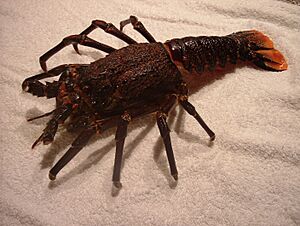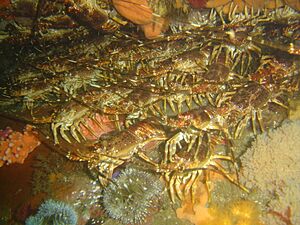Cape rock lobster facts for kids
Quick facts for kids Cape rock lobster |
|
|---|---|
 |
|
| Conservation status | |
| Scientific classification | |
| Genus: |
Jasus
|
| Species: |
lalandii
|
| Synonyms | |
|
Palinurus lalandii H. Milne-Edwards, 1837 |
|
The Jasus lalandii, also known as the Cape rock lobster or West Coast rock lobster, is a type of spiny lobster. You can find it living off the coast of Southern Africa. We don't know for sure who the name lalandii honors. It might be named after a French scientist called Pierre Antoine Delalande.
Contents
Where Do Cape Rock Lobsters Live?
You can find Jasus lalandii in the ocean from Cape Cross in Namibia all the way to Algoa Bay in South Africa. This area includes the famous Cape of Good Hope. These lobsters usually live in shallow waters, but they can be found as deep as 46 meters (about 150 feet). They prefer to live on rocky parts of the ocean floor.
Eating Cape Rock Lobsters
In South Africa, people often call this lobster crayfish (or kreef in Afrikaans). It's a popular food, especially in coastal areas. People often cook it on a braai, which is like a barbecue. However, too many lobsters have been caught, which means there are fewer of them now.
What Does a Cape Rock Lobster Look Like?
Cape rock lobsters are usually orange to reddish-brown. They have long feelers, called antennae, that stick out from the front of their heads. Their tail fan is colorful, with orange, blue, and green parts. Their body, called the thorax, is spiny. They have black eyes that are on stalks.
How Do Cape Rock Lobsters Live?
These lobsters mostly live on rocky reefs. They like to hide in small cracks and holes, called crevices, for safety. You can often see groups of them with their antennae poking out from their hiding spots. If they need to escape quickly, they can swim backward using their tail. Most of the time, though, they just crawl around on the reef.
Who Eats Cape Rock Lobsters?
Some animals that hunt and eat rock lobsters include seals, sharks, and large fish. Sometimes, if the water doesn't have enough oxygen, many lobsters can get sick. This can cause them to wash up on the shore in large numbers.
What Do Cape Rock Lobsters Eat?
Jasus lalandii is a generalist predator and scavenger. This means they eat many different things and also clean up dead bits of food. They like to eat mussels, sea urchins, abalone, and barnacles. If they have a choice between abalone and sea urchins, they often prefer abalone. When they eat sea snails, they pick smaller ones. This is because it's less risky to attack smaller prey. They can crack open small snail shells completely. For bigger snails, they chip away at the shell until they can pull out the soft part. This shows that rock lobsters try to get the most food with the least amount of danger.
Fishing for Cape Rock Lobsters
Cape rock lobsters can grow quite large, up to 46 centimeters (about 18 inches) long. Their main body shell, called the carapace, can be up to 18 centimeters (about 7 inches) long. People catch a lot of these lobsters for their meat. Over 6,500 tons are caught each year using special traps called lobster pots and hoop nets.
To stop too many lobsters from being caught, the government of South Africa has rules. They give out special permits called individual fishing quotas to fishermen and companies. These permits limit how many lobsters can be caught each year, usually around 1,700 tons in total. There is also a time of year when no one can catch lobsters, from June 1st to November 15th. Lobsters must also be at least 80 millimeters (about 3 inches) long (measured by their carapace). It is also against the rules to catch female lobsters that are carrying eggs.




